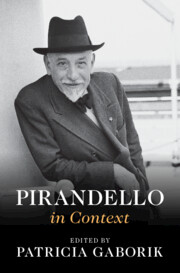Book contents
- Pirandello in Context
- Pirandello in Context
- Copyright page
- Dedication
- Contents
- Figures
- Contributors
- Preface
- Acknowledgments
- Chronology
- List of Cited Titles in Translation and the Original Italian
- Part I Places
- Part II Institutions
- Part III Interlocutors
- Part IV Traditions and Trends, Techniques and Forms
- Chapter 18 Humor
- Chapter 19 Dialect Theatre
- Chapter 20 Metatheatre
- Chapter 21 The Fourth Wall
- Chapter 22 The Anti-Character
- Chapter 23 Myth
- Chapter 24 The Fantastic
- Part V Culture and Society
- Part VI Reception and Legacy
- Further Reading
- Index
Chapter 24 - The Fantastic
from Part IV - Traditions and Trends, Techniques and Forms
Published online by Cambridge University Press: 14 March 2024
- Pirandello in Context
- Pirandello in Context
- Copyright page
- Dedication
- Contents
- Figures
- Contributors
- Preface
- Acknowledgments
- Chronology
- List of Cited Titles in Translation and the Original Italian
- Part I Places
- Part II Institutions
- Part III Interlocutors
- Part IV Traditions and Trends, Techniques and Forms
- Chapter 18 Humor
- Chapter 19 Dialect Theatre
- Chapter 20 Metatheatre
- Chapter 21 The Fourth Wall
- Chapter 22 The Anti-Character
- Chapter 23 Myth
- Chapter 24 The Fantastic
- Part V Culture and Society
- Part VI Reception and Legacy
- Further Reading
- Index
Summary
The chapter makes a case for Pirandello as the head of an Italian school of fantastic literature that came into being at the end of the nineteenth century. It recounts Pirandello’s use of the fantastic – characteristically without the supernatural – as a tool for distancing himself from the naturalism of the period and as a literary strategy that shared much with the humorism that was likewise dear to Pirandello. Both the fantastic and the humoristic relied on the perception of life’s contrasts to slowly overturn an understanding of the laws of the universe. Focusing on the Stories for a Year, the chapter traces the sometimes uneasy coexistence of the fantastic and humoristic, chronicles Pirandello’s original recreation of fantastic situations and environments in a wholly Sicilian imaginary, and reflects on how the fantastic itself becomes a metaphor for literary creation.
Keywords
- Type
- Chapter
- Information
- Pirandello in Context , pp. 195 - 202Publisher: Cambridge University PressPrint publication year: 2024

